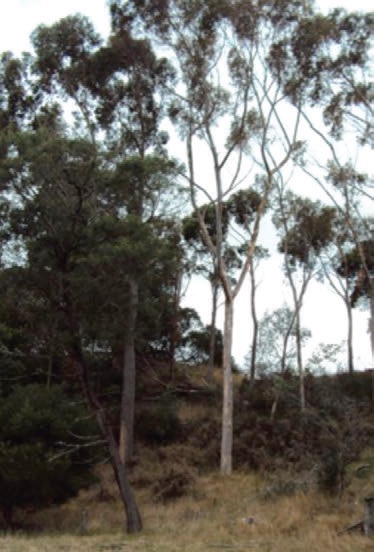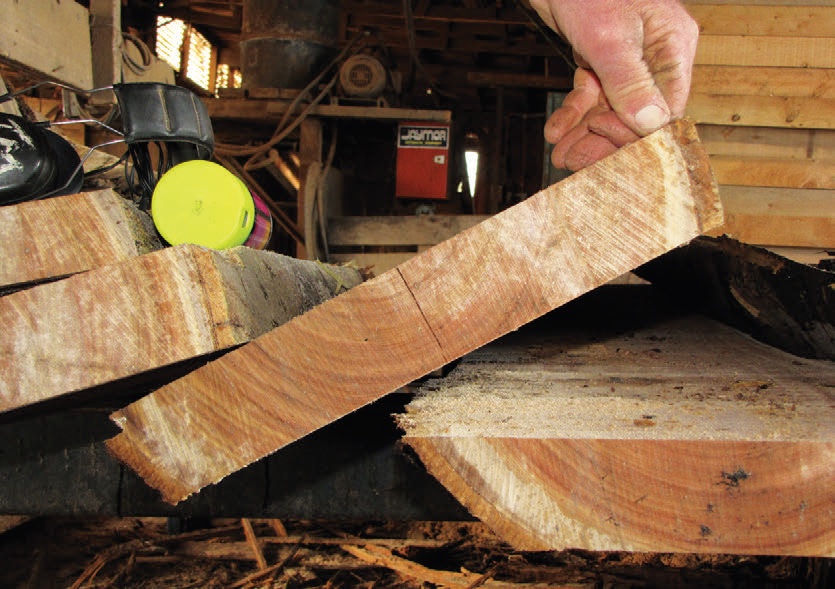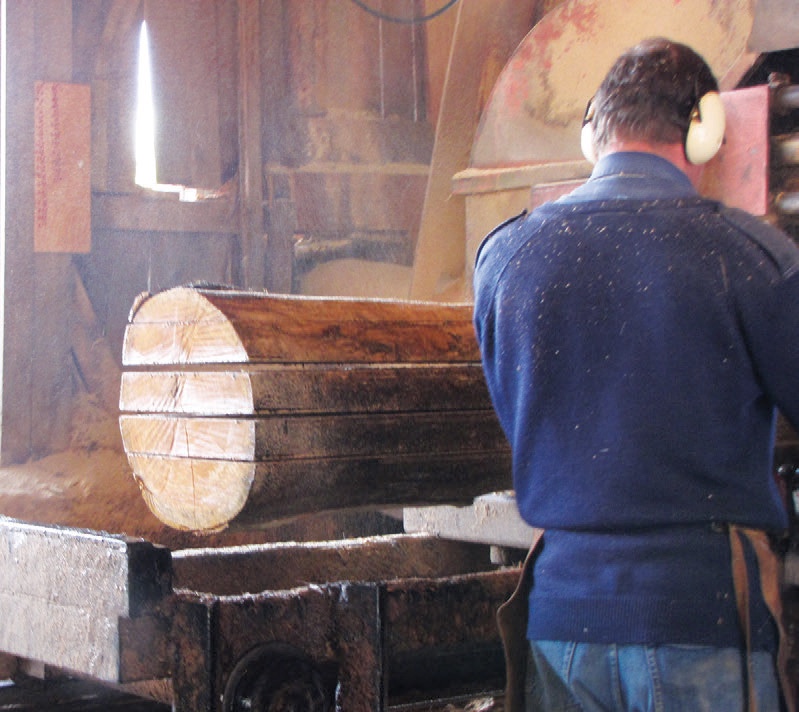Eucalyptus cladocalyx ? Adolescent with an attitude problem?
Denis Hocking, New Zealand Tree Grower August 2010.
Eucalyptus cladocalyx is not one of the common farm forestry species in New Zealand and has been planted in only limited numbers round the country. There are specimens around but I have heard few comments about growth or performance and am only aware of one sawing experience in New Zealand.
I planted a few E. cladocalyx on my sand dunes in the early 1980s and have recently sawn all of two trees. As a relatively experienced E. cladocalyx operator here are a few comments on what I have found.
Drought tolerance
First, the species commonly known as sugar gum, is classified as a member of the Symphyomyrtus subgenus but appears to be an outlier, having no close affinities with any other eucalypt species. It is one of the most drought tolerant of the larger eucalypts and will grow in areas with less than 400 mm of annual rainfall, with some rather unusual adaptations.
It can have a huge root extent, but retains the more horizontally held, discolorous leaves which are darker on one side than the other, an ancestral feature of its rain forest predecessors. Most low rainfall eucalypts have concolorous leaves that hang vertically to reduce light interception and evapo-transpiration in the heat of the day. However, E. cladocalyx does have a very light canopy with leaves at the very ends of the branches. It is a general eucalypt characteristic but exaggerated in this species.
Its natural range is restricted to three occurrences in South Australia − eastern Kangaroo Island, eastern Eyre Peninsula and southern Flinders range, and soils are described as ‘mainly skeletal or podzolic and rather shallow’. It has been planted quite widely in south eastern Australia, often for amenity purposes. But in western Victoria it was widely planted as a shelterbelt species, sometimes using agricultural drills to plant seed directly. These trees are often coppiced with the wood being used for posts, poles and especially firewood. I understand their form largely precludes sawlog options.

Ground durability
In the earlier Australian literature E. cladocalyx was rated class two for durability in the ground – 15 to 25 years for a 50 mm by 50 mm stake. However more recent work has indicated that it is one of the most durable of the eucalypts, similar to the better ironbark and box species, and clearly warrants a class one rating.
It is currently the subject of an Australian breeding programme looking at ground durable species for the drier areas of the south east, with vineyards identified as the key market for naturally durable pole material. Their work indicates good natural durability, high yields of heartwood and the possibility of significant genetic improvement.
The Flinders Range provenances were found to be markedly superior. They are looking to produce posts from trees down to only eight years old.
Mixed feelings
I have had mixed feelings about E. cladocalyx over the years. Good establishment and vigorous early growth enthused me, but then the form deteriorated along with my enthusiasm. E. cladocalyx might be described as ‘an adolescent with an attitude problem’. It grows at an alarming rate, but lacks straight backed, military discipline, refusing to stand up straight and slouches badly.
It tends to be a long, lean tree with diameter growth lagging behind height growth, perhaps reflecting the light canopy held right out at the ends of the branches. A few of my trees are producing straight, butt logs that would appeal to a sawmiller, most are not. I understand that the form in Australia also leaves much to be desired.
Some provenances are rather frost tender and the foliage is quite poisonous, thanks to cyanoglycosides. But there are also some good points. It seems to have no significant insect pests, tolerates our rather saline sand country winds, is a good late summer nectar tree and coppices vigorously, if that is considered desirable. It is also very good for firewood.
Harvesting
I harvested two, 27 and 28-year-old trees last year, of reasonable form, with diameters at breast height of approximately 55 cm. They were therefore growing at approximately two centimetres a year which is certainly respectable, but considering site and stocking, significantly behind my better species.
Both were threatening to drop large branches over my drive. What was immediately striking was the very high percentage of heartwood. Both five metre butt logs, with small end diameters of approximately 50 cm had a sapwood band of no more than 2.5 cm, as shown in the photograph, meaning 80 per cent heartwood. The Australians report over 60 per cent heartwood for much younger, smaller trees. These high heartwood yields probably reflect the light crowns of this species.
Milling
There was little sign of end checking in the logs through to milling six months later. They were milled in 2.5 metre lengths to produce 70 by 70 mm vineyard posts for Paul Millen. They behaved very well, with little evidence of growth stresses and yielded fifty 2.5 metre heartwood posts as well as thirteen 1.5 metre heartwood stakes, representing around 40 per cent of total log volume.

There was also some smaller dimension and sapwood containing timber sawn from the logs. The milling was undertaken at a local sawmill using a horizontal band saw and breast bench arrangement.
The wood is extremely hard and the saw needed considerably more cooling water than when cutting E. muelleriana, E. saligna or E. microcorys. The Australian literature quotes density figures of 1,100 kg per cubic metres and I can believe this, although I have no figures for New Zealand.
The timber, both sap and heartwood, is very light in colour, almost white and without clearly distinguishable growth rings. My furniture timber ‘consultants’ at our local polytechnic thought it was pretty cool, but you might need a crane to shift the table.

Overall summary
So in summary, and with very limited local experience I would describe E. cladocalyx as follows −
- A tall, skinny tree of rather suspect form, with a notably light canopy
- Very tolerant of dry and relatively infertile sites, also wind, but somewhat frost tender
- No insect pests, good nectar tree
- Very high yields of high durability heartwood, timber light in colour, stable, very hard and dense
- Behaves well during sawing with minimal growth stress problems but make sure your saw is very sharp.
Should we be growing more E. cladocalyx? I do not know. On the basis of my experience I may plant a bit more but I would not put it in my "A team" of the stringybarks and E. microcorys (plus E. fastigata on colder sites). If I was to plant more I would like to get hold of the better Australian selections.
I feel that yields of millable logs are likely to be significantly lower or even much lower than for other species. It could certainly be used for coppice stands for durable posts, although coppice growth often suffers significant heartwood rot, even in high durability species.
If it has a role, I would suggest it is on hot, dry north facing slopes. Here it may be a very useful soil conservation species with its very extensive, durable root system and potential for cropping before it gets too big.
One anecdotal claim I recall was roots as thick as your wrist 100 metres from a tree. If you have such sites and an interest in high durability timber then it is definitely worth considering. I am just not so sure about trying to grow volumes of it for higher value, sawn timber end uses.

 Farm Forestry New Zealand
Farm Forestry New Zealand